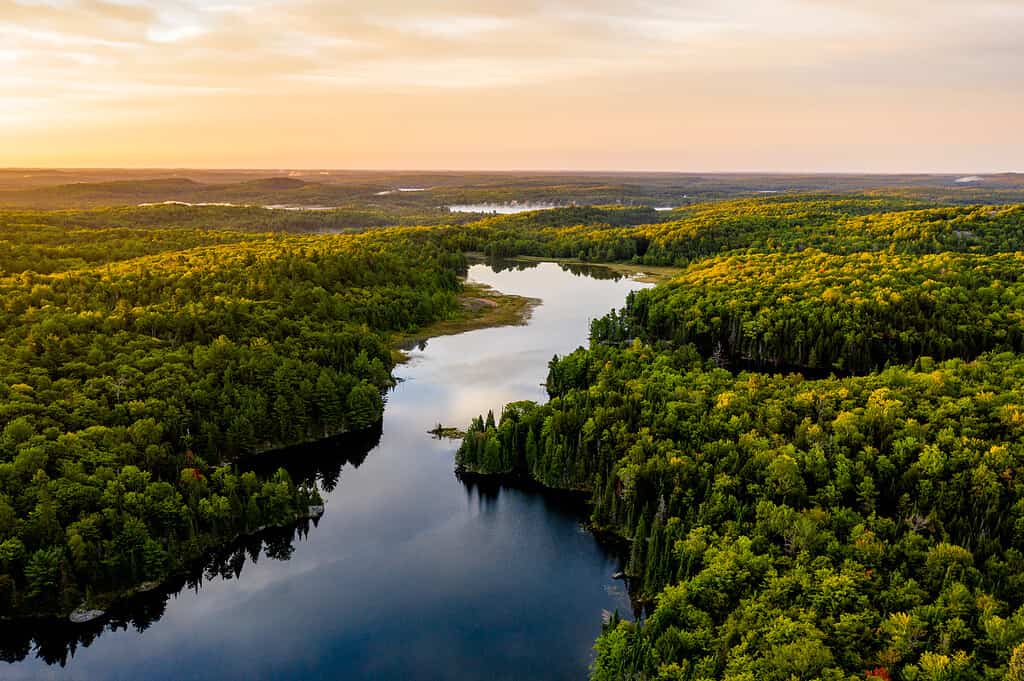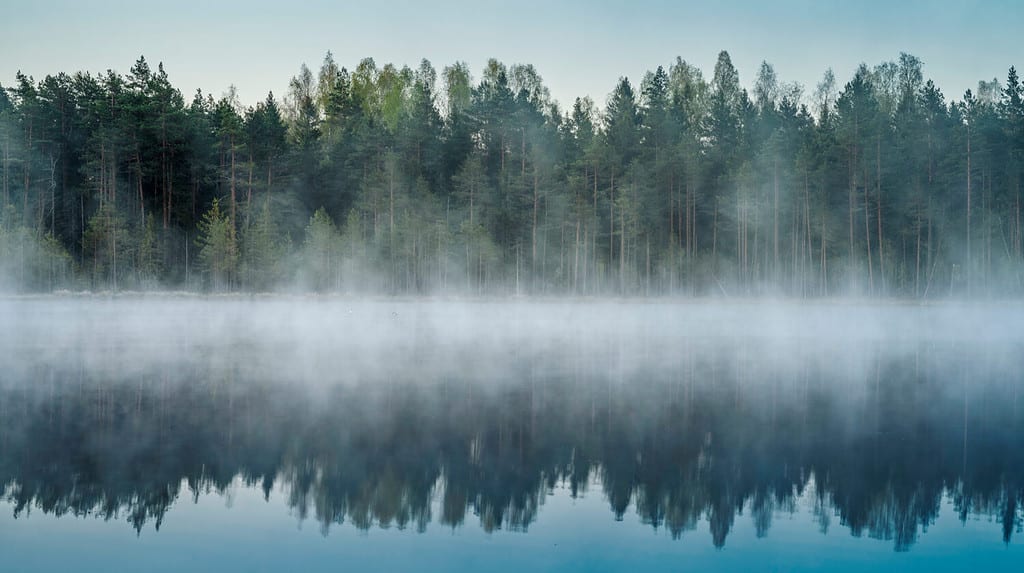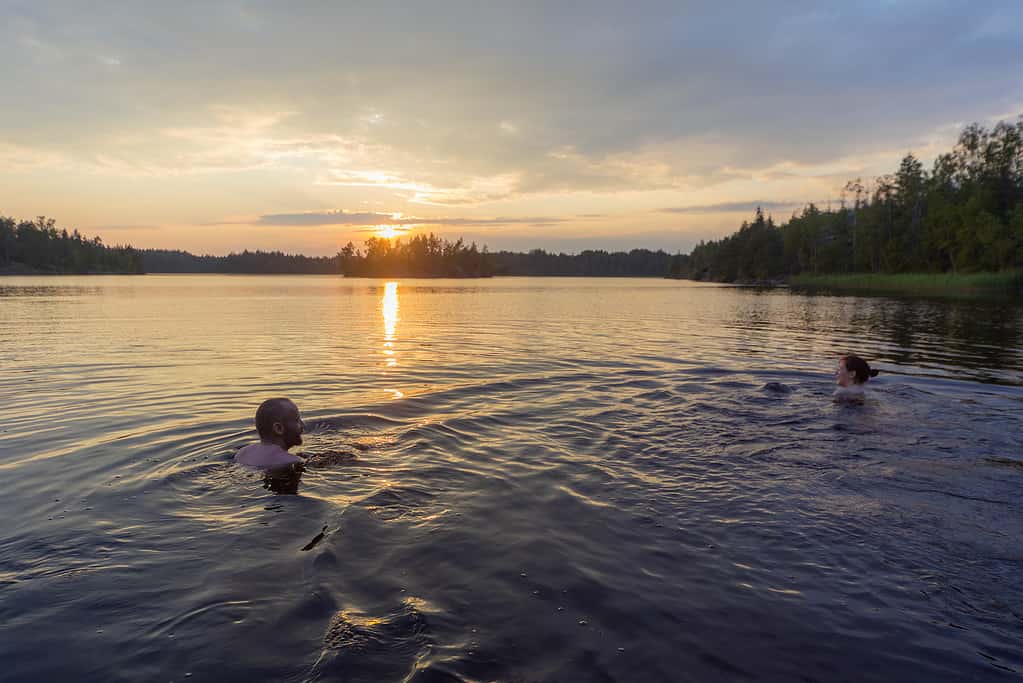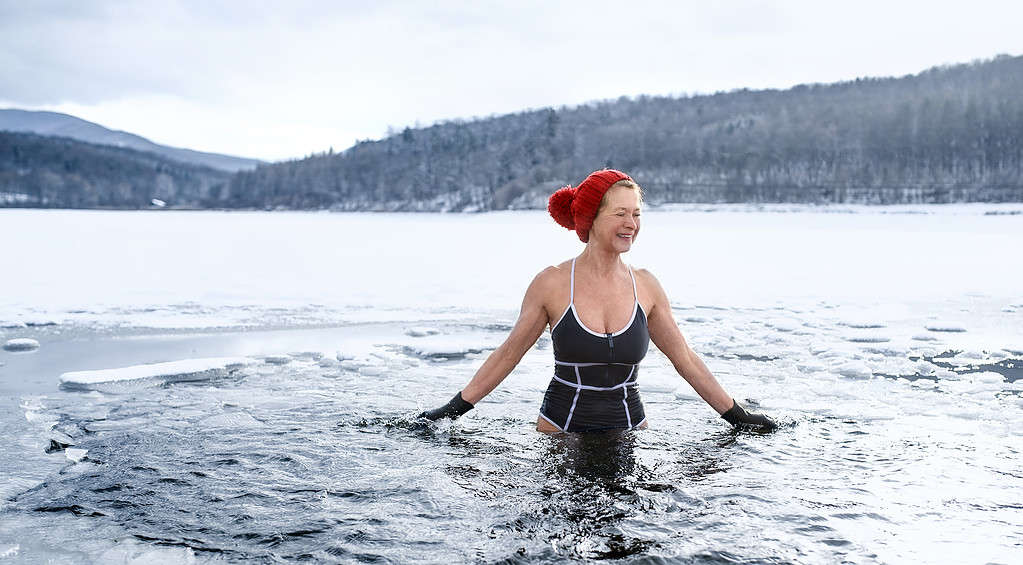Lake of the Woods resides across a northern part of the U.S. state, Minnesota, as well as parts of various Canadian provinces, including Ontario and Manitoba. As a massive body of water, it’s natural to ask what’s in Lake of the Woods and if it is safe to swim in.
It is a breathtaking expanse of freshwater that has a surface area of 4,350 kilometers (1,679.5 square miles). Moreover, its length extends approximately 109 kilometers (68 miles), while its width is about 95 kilometers (59 miles). The maximum depth of this lake is roughly 64 meters (210 feet). Excluding its 14,632 islands, its shore length extends approximately 40,000 kilometers (25,000 miles). In contrast, including its many islands, its estimated shore length exceeds 105,000 kilometers (65,000 miles). These factors influence this lake’s popularity for various outdoor recreational activities, including swimming.
Shared by Canada and the United States, this incredible lake offers a stunning escape into the natural world that encompasses this region. But before you dive in, it’s crucial to assess its safety. Let’s explore the safety factors when considering swimming in Lake of the Woods, in addition to the water quality, wildlife residing in and around the lake, and conservation efforts to preserve and protect it.

Though not inherently dangerous, before swimming in Lake of the Woods, there are several factors to consider, such as water temperature, potential algae growth, personal skill level, and various other factors.
©Paul Hartley/iStock via Getty Images
Is Lake of the Woods Safe to Swim In?
While Lake of the Woods is not inherently dangerous, there are factors to consider to ensure you have a safe and comfortable experience swimming in this gigantic body of water.
Aquatic and Terrestrial Animals
Lake of the Woods teems with a diverse array of aquatic and terrestrial life, both large and small. One of the most prominent creatures in these waters is muskellunge, a formidable predator that can grow to impressive sizes. While these fish are not inherently dangerous to swimmers, they have been known in rare instances to attack swimmers, likely as a territorial response. Additionally, snapping turtles are known to inhabit the lake and lakeshore. Although these reptiles are not aggressive, their powerful jaws and sharp beaks can deliver a dangerous bite if provoked. These creatures will avoid humans at all costs, but swimmers should know to avoid handling them and give them the space they require.
Furthermore, many land animals could become dangerous if specific encounters occur. Moose and black bears are highly protective of their young. If they feel cornered or provoked, they will attack defensively. If you encounter these animals with their young, give them a wide birth and do not provoke them. Moreover, stringing insects, such as hornets, can pose a risk if you stumble across their nests or are stung by one. Lastly, cougars also inhabit the area. They are stalking predators and are arguably the most dangerous land animals in this region. They are unlikely to pursue prey or mistake prey such as humans in the water.
On the whole, all of these land-dwelling animals can be found around or even in Lake of the Woods on occasion. Having an awareness of their presence and being prepared if you encounter them will ensure your best chances of safely sharing space with them.
Water Temperatures
Lake of the Woods experiences dramatic fluctuations in water temperature throughout the year. In the summer months, surface temperatures can reach a cold but tolerable range for swimming. It typically ranges between 15.6 to 18.3 degrees Celsius (60 to 65 degrees Fahrenheit). The shallow sections can heat up nicely and allow for even warmer temperatures. However, deeper portions of the lake can be significantly colder, making it essential to be aware of potential thermoclines, which are abrupt temperature shifts in the water column. The colder waters can create discomfort or even pose a major risk of hypothermia for swimmers, paddleboarders, kayakers, and the like.
During the winter, Lake of the Woods is known to freeze over, with ice thick enough to support activities like ice fishing and snowmobiling. However, ice conditions can be unpredictable, and it is vital to follow local authorities’ guidelines and safety measures when considering winter activities on the lake.
Aquatic Plants
Lake of the Woods is home to various aquatic plants that thrive in its nutrient-rich waters. While these plants contribute to the lake’s overall ecological health, they can pose certain challenges for swimmers. Submerged aquatic vegetation, such as water lilies and Eurasian watermilfoil, may grow in shallow areas. Swimmers should exercise caution to avoid entanglement in these plants, which can hinder movement and create potential safety hazards.
Furthermore, it is essential to be aware of the presence of harmful algal blooms (HABs). HABs can occur when excess nutrients, primarily phosphorus and nitrogen, promote the rapid growth of algae. Some types of algae in these blooms can produce toxins harmful to humans and animals. The symptoms of exposure to these toxins include skin irritation, gastrointestinal distress, and, in severe cases, neurological symptoms. Monitoring of water quality and advisories from local authorities is crucial to avoid swimming in areas affected by HABs.
Lastly, various plants near the shores of Lake of the Woods are poisonous to touch. Such plants can include poison ivy, poison oak, wild hemlock, and water hemlock. Contact with any of these plants can result in skin irritations or allergic reactions. Moreover, if water hemlock or wild hemlock are ingested, they can cause fatal respiratory and neurological responses.
Swimming Safety Summarized
Lake of the Woods is a magnificent natural body of water that offers recreational opportunities like swimming. However, it is not without uncommon yet potential dangers. Swimmers should exercise caution when encountering muskellunge and snapping turtles, be mindful of temperatures, especially in deeper waters, and navigate carefully around plants and wildlife. Additionally, vigilance is essential regarding the presence of harmful algal blooms, as exposure to their toxins can have adverse health effects. By understanding these factors and adhering to local safety recommendations, visitors to Lake of the Woods can enjoy its expansive waters while minimizing potential risks.

Lake of the Woods is approximately 109 kilometers (68 miles) long, 95 kilometers (59 miles) wide, and has a surface area of 4,350 kilometers (1,679.5 square miles).
©ChamanExperience/Shutterstock.com
Lake of the Woods Water Quality
One of the foremost considerations for many aware and discerning visitors is the water quality of this vast freshwater expanse.
Overall, Lake of the Woods boasts generally good water quality. However, it can vary significantly within each section of the lake. The lake’s cleanliness can be attributed to its relatively remote location, the absence of major industrial pollution sources in its immediate vicinity, and effective environmental stewardship efforts by both Canadian and American authorities. However, natural conditions have influenced water quality issues. Various inflows of water into the lake, such as the Rainy River, bring an influx of high concentrations of nutrient-dense water. This can influence harmful algae blooms or harmful algae activity in the right circumstances.
Contributing Factors to Water Quality
Limited Industrial Presence
The lake’s remote location means it is not exposed to heavy industrial activities that can contribute to water pollution. This isolation has helped maintain the water’s natural purity.
Low Population Density
The surrounding region has a low population density, reducing the discharge of pollutants into the lake from urban areas. Local authorities have also implemented regulations to manage septic systems and control nutrient runoff.
Stringent Environmental Regulations
Both Canada and the United States have implemented strict environmental regulations to protect the lake. These regulations include controlling nutrient inputs, managing wastewater discharge, and preventing contamination.
Algae Problems
Lake of the Woods, like many freshwater bodies, can experience algae problems, particularly harmful algal blooms. HABs can occur when excess nutrients, primarily phosphorus and nitrogen, enter the water, fueling the rapid growth of algae when temperatures are favorable. These blooms can lead to water quality issues and pose risks to animal life and human health.
The lake has occasionally faced HABs, prompting concern among local authorities and environmental organizations. Efforts to monitor and manage nutrient inputs, including agricultural runoff and wastewater discharge, are crucial in mitigating the occurrence of HABs. Ongoing research and collaboration between Canada and the United States seek to better understand and address this challenge.
Pollution Concerns
Lake of the Woods is generally considered to have low pollution levels compared to many other bodies of water. The collaborative efforts of Canadian and American agencies, such as the Lake of the Woods Water Sustainability Foundation, focus on maintaining and improving water quality.
Pollution concerns that do exist stem primarily from non-point source pollution, such as agricultural runoff, atmospheric deposition of pollutants, and natural sediment pollutants. While these concerns are not unique to Lake of the Woods, they underline the importance of ongoing efforts to manage, reduce, and educate about environmental impacts.
Water Quality Summarized
Lake of the Woods is a good example of the harmonious coexistence of nature and human stewardship. Its waters are generally clean, especially further north, owing to its remote location, low population density, and stringent environmental regulations. While it can face challenges in the form of harmful algal blooms due to non-point pollutants, proactive measures are in place to monitor and mitigate these issues. Furthermore, pollution concerns primarily revolve around non-point source pollution, emphasizing the need for continued vigilance and conservation efforts.
Furthermore, Lake of the Woods remains a shining example of a preserved natural treasure, where the convergence of science, policy, and environmental consciousness ensures the protection of its expansive waters.

Lake of the Woods is overall a safe lake to swim in.
©Valdis Skudre/Shutterstock.com
Lake of the Woods Wildlife
Nestled between the United States and Canada, Lake of the Woods is home to a thriving ecosystem teeming with diverse wildlife.
Aquatic Animals
Lake of the Woods is renowned for its rich and varied fish populations, making it a prime destination for anglers and a sanctuary for aquatic biodiversity. Beyond fish, the lake supports various aquatic organisms as well. Among the notable aquatic species inhabiting these crystal-clear waters include the following.
Walleye (Sander vitreus)
The walleye is a prized catch for its delectable flesh. These nocturnal predators thrive in Lake of the Woods’s cool waters, and their amber eyes make them superb low-light hunters.
Northern Pike (Esox lucius)
The northern pike is a top predator in the lake with its long, torpedo-like body and many sharp teeth. These ambush hunters lie in wait, ready to strike at passing prey.
Lake Trout (Salvelinus namaycush)
The lake trout, a cold-water species, have long and thick bodies. They can grow to impressive sizes and inhabit the deeper, cooler portions of the lake.
Smallmouth Bass (Micropterus dolomieu)
Anglers prize smallmouth bass for their spirited fights and are commonly found in the rocky shallows of Lake of the Woods. Their bronze-colored bodies and crimson eyes make up their appearance.
Muskellunge (Esox masquinongy)
Known as “muskie” by anglers, these apex predators are known for their elusive nature and impressive size. Catching a muskie is considered a big achievement. Lake of the Woods is highly regarded for its muskellunge fishing opportunities.
Yellow Perch (Perca flavescens)
Yellow perch are an attractive schooling fish that thrive in the lake’s shallower regions. Their striking yellow coloration and distinctive stripes make them easily recognizable.
Cisco (Coregonus artedi)
Also known as lake herring, ciscoes are an essential part of Lake of the Woods’ food web. They are plain-looking fish in appearance, and they provide a crucial food source for larger predators.
Zebra Mussels (Dreissena polymorpha)
Zebra mussels are an invasive species residing in the Lake of the Woods. Though they can help by improving water quality, they pose a danger to native species when it comes to resources. Zebra mussels are incredibly difficult to manage, let alone eradicate, as they can easily survive out of water for up to seven days and are also easily transported by fishing vessels.
Aquatic Insects
A diverse array of aquatic insects, such as mayflies, dragonflies, and caddisflies, serve as essential prey for fish and other wildlife.
Terrestrial and Avian Animals
The lush woodlands surrounding Lake of the Woods and its shoreline offer a haven for a wide range of mammals, birds, and other animals that live primarily on land. Each is adapted to the unique environment surrounding Lake of the Woods.
White-tailed deer (Odocoileus virginianus)
These graceful herbivores are a common sight around the lake, often foraging near the water’s edge.
American Black Bear (Ursus americanus)
While often elusive, black bears call the forests surrounding Lake of the Woods home. They play a crucial role in maintaining ecosystem balance and can be spotted near the water’s edge.
Red Fox (Vulpes vulpes)
These cunning predators are skilled hunters, often found near the shoreline, where they search for small mammals and birds.
North American River Otter (Lontra canadensis)
North American river otters are playful and agile swimmers who frequent the lake’s shoreline. They are a testament to the health of the aquatic ecosystem.
American Beaver (Castor canadensis)
Lake of the Woods offers an ideal habitat for beavers, with its abundance of waterways for dam-building and ample vegetation for sustenance.
Moose (Alces alces)
These giants of the Northwoods are occasionally spotted near the lake, especially in the more remote areas. However, they have a preference for wetlands surrounding the lake.
Bald Eagle (Haliaeetus leucocephalus)
These majestic raptors are a symbol of strength and grace and are often seen soaring above the lake, searching for fish.
Common Loon (Gavia immer)
The hauntingly beautiful calls of loons echo across the lake. These iconic aquatic birds are known for their striking plumage and remarkable diving abilities. Moreover, these birds cannot walk or survive on land. They rely on water to survive and thrive.
Great Blue Heron (Ardea herodias)
With their tall, statuesque figures, great blue herons wade along the lake’s shores, often hunting for fish and amphibians.
Common Tern (Sterna hirundo)
These agile, acrobatic birds make impressive dives into the lake to capture fish. They are quite small and only weigh up to 4.2 ounces on average.
Osprey (Pandion haliaetus)
Ospreys are skilled fishers, often seen hovering above the lake before plunging to snatch their prey. These raptors can grow to impressive sizes.
In the harmonious circle of life taking place in and around Lake of the Woods, aquatic species thrive beneath the shimmering surface. At the same time, mammals, birds, and countless other creatures find refuge in the surrounding woodlands and shorelines. This pristine ecosystem consists of a delicate balance of nature and the importance of conservation efforts to preserve its beauty and health.

Lake of the Woods is a popular destination for recreational activities, including swimming.
©Argument/iStock via Getty Images
Conservation of Lake of the Woods
Lake of the Woods benefits from the dedicated commitment to conservation that has been taken to protect it. Numerous efforts have been underway and established to safeguard its ecological integrity and maintain its health.
Lake of the Woods Water Sustainability Foundation
This organization, supported by governmental and non-governmental partners, conducts extensive research to monitor water quality and address issues like harmful algal blooms. Their work helps inform conservation strategies against pollution of all kinds.
International Joint Commission (IJC)
The International Joint Commission plays a crucial role in managing and protecting shared waters. Its initiatives include the development of nutrient reduction strategies to mitigate algal blooms and conducting assessments to guide conservation efforts.
Local Stewardship Groups
Various local groups and associations around Lake of the Woods are actively involved in conservation. They engage in shoreline restoration projects, promote responsible fishing practices, and educate the public about the importance of protecting the lake.
Water Quality Monitoring
Continuous monitoring of water quality parameters ensures that any emerging threats are detected early. This data guides policymakers and conservationists in making informed decisions.
Environmental Regulations
Stringent environmental regulations in both Canada and the United States govern activities on and around Lake of the Woods, from wastewater management to land use planning, to minimize impacts on the lake’s ecosystem.
Through collaborative efforts, Lake of the Woods remains a shining example of effective cross-border conservation, preserving its natural beauty and vital ecological functions for generations to come.

Lake of the Woods is not a year-round swimming lake. However, cold water plunging can be done by following sufficient safety measures.
©Halfpoint/iStock via Getty Images
Conclusion
Overall, Lake of the Woods is a safe body of water to swim in. It is generally a clean lake with suitable water quality. However, it does experience harmful algae blooms (HABs) on occasion due to non-point pollutants. The water temperature runs cold but is tolerable for summer swimming. Moreover, shallower areas can warm up to pleasant temperatures. Due to its remote location, there is plentiful wildlife. As a massive lake surrounded by incredible natural beauty, it is a popular destination for outdoor recreation.
The photo featured at the top of this post is © ChamanExperience/Shutterstock.com
Thank you for reading! Have some feedback for us? Contact the AZ Animals editorial team.






